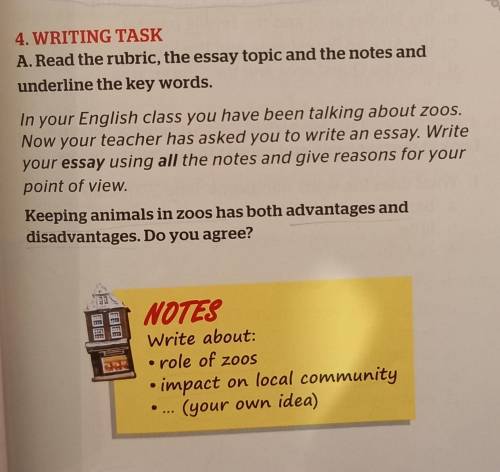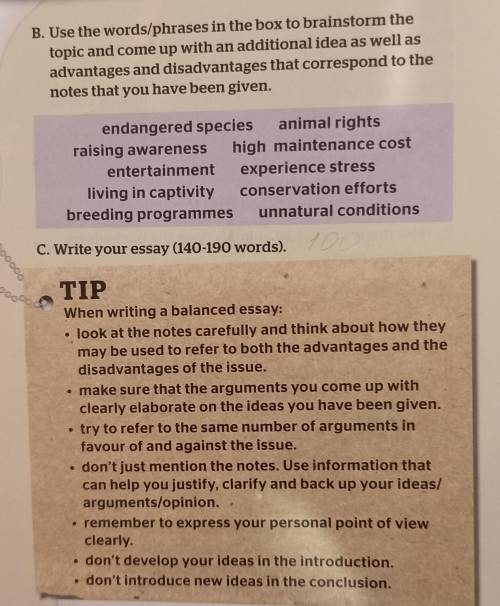Нужно написать эссе про преимущества и недостатки зоопарков по плану на фото! Нужно 100- 120 слов !


Другие вопросы по теме Английский язык
Популярные вопросы
- 7)Does the design to the new regulations? Выберите один ответ. agree confirm consist...
1 - 50:2(40+10):2=20+5=25Обьясни деления...
2 - Які водорості мають тільки одноклітинні форми?...
3 - На стороні AB трикутника ABC позначено точку M так, що AM:MB=1:3. Знайдіть координати:...
1 - Знайдіть радіус кола, якщо його d=6см...
3 - 4. Спишите предложения с обособленными приложениями, расставьте знакипрепинания,подчеркните...
3 - С каким из этих двух океанов связаны открытия, совершенные путешественниками и...
1 - До кого хлопцi вiднесли сороку з твору Шпага Славка Беркути...
2 - 1.що таке подразливість? як вона проявляється?2 .Які існують типи нервових систем?3....
1 - Смешали 25 г соли и 35 г воды Какова Массовая доля соли в растворе...
2
Здесь намного больше :)
Объяснение:
he fact that wild animals are still kept in limited conditions for the amusement of the human race is a problem that is widely discussed in eco – advocacy circles. Let's try to figure out if this is really as bad as we are told about it.
Positive
Simplify research. Although there are many different lotions that allow scientists to monitor wild animals in their habitats, but their installation requires a lot of financial and physical costs. In addition, if the camera installed in the jungle breaks down, it will need to be replaced – which means even more costs... in other words, placing the animal in the zoo allows you to "not go far" and conduct research on the spot, while not causing the animals discomfort. This moves biology forward, and sometimes helps to preserve individual representatives of the animal world.
Caring for endangered species. Not every animal brought to the zoo was poached – most often it happens just the opposite. This is especially true for those species of animals whose population in nature is declining for one reason or another. Placing them in a zoo allows scientists to monitor the state of the species, its population, and take the necessary measures to preserve it.
Safety. In addition to the one hundred percent chance to continue their kind due to the conditions created for this, animals kept in zoos have another decent advantage: they are protected from natural selection. The zoo staff does not care, for example, if one lion cub from the litter turns out to be weaker than another and could not get food for itself in the wild - all the lion cubs will be taken care of. The same thing will happen if, for example, an animal gets sick – they will definitely come out and save it, which will not happen in the wild. Finally, the herbivores living in zoos can not be afraid of a predator attack, as they will be separated by several enclosures.
Visibility. Although the opportunity to stare at the locked animals may sometimes seem like a privilege of an impudent person who has nothing sacred in relation to nature, very often a visit to the zoo can be equated with an educational excursion. This is especially important for schoolchildren, when they can see firsthand the animals that have just looked at them from the pages of biology textbooks.
Animals in the zoo
Cons
Space restriction. Of course, after the wild nature, a cramped enclosure will seem like a prison, not to mention the conditions of detention. There is a difference between the endless jungle and fields where you can walk forever in search of delicious grass or flocks of unsuspecting antelopes, and a small room in which you put the right food without having to look for it. In addition, the difference in climate can affect: an animal of the far north, for example, a polar bear, will feel disgusting even in a temperate zoo.
Constant human attention. Unfortunately, few visitors to zoos are familiar with the culture of communicating with animals, and warning signs help only in rare cases. For example, many people think that ducks can be fed bread slices, although this is not true – in fact, these pieces are too large, which makes it difficult for even an adult to digest them. The lack of attention of the zoo staff leads to serious health problems.
Ill-treatment. This seems to be the least of the evils, because everyone is accustomed to believe that only those who love nature and therefore will not allow themselves to mistreat animals go to work in the zoo. Alas, the love of animals is a stretchable concept, and no one has been able to heal the elementary human cruelty, short-sightedness, and negligence so far. Animals that lack attention and care can die, which would not happen in the wild.
"Domestication" of animals. An animal born and raised in captivity can never become a full-fledged inhabitant of the wild. This is a God-knows-what drawback, because cases in which an animal needs to be taken out are very rare. However, in a situation of extinction of a species, when one representative is wild, and the second is from the zoo, mating may not occur due to the unattractiveness of one of the partners and the inability to survive in the wild.
Conclusion
Not all zoos are as bad as they seem. If the animals are watched by people who really know what they are doing, these organizations do much more good than harm. But if it is obvious that the management of the zoo is not coping with its duties, and the animals are suffering, it is necessary to sound the alarm and take action. To do this, of course, you need to be very careful.